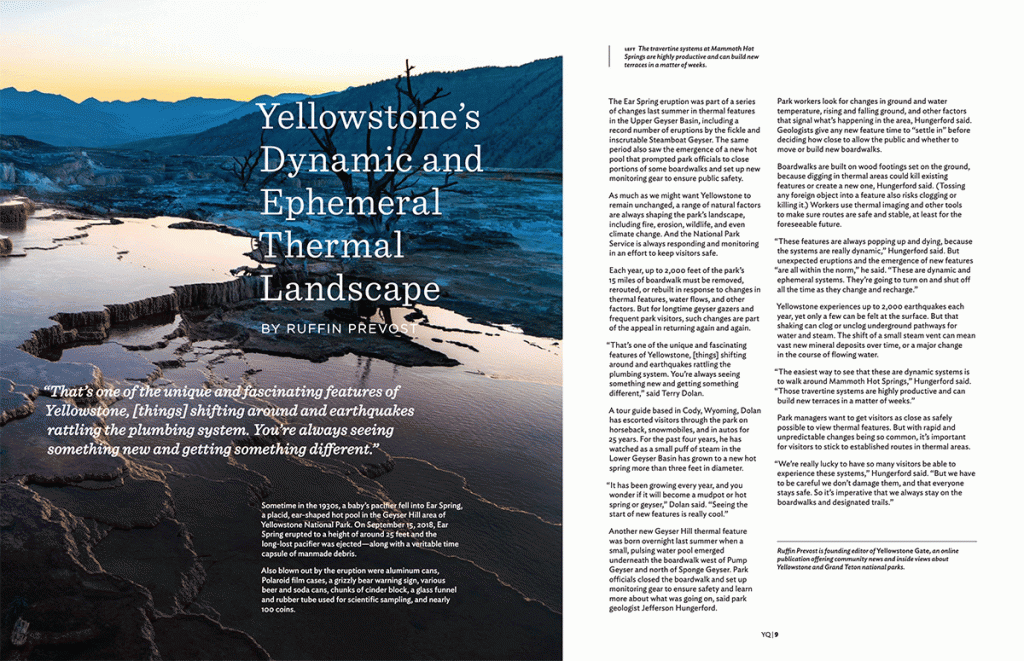
I have covered northwestern Wyoming for 25 years, most recently with a focus on travel and tourism in Yellowstone and Grand Teton national parks. My work as a staff writer and freelancer includes in-depth investigative pieces, breaking news, features, hotel and restaurant reviews, multi-part series, personality profiles and consumer magazine articles.
Please take a look at some of what I have written over the past few years.
Travel & Tourism • Investigative • Features & Assignments • Profiles
Travel & Tourism
Yellowstone National Park attracts 4 million visitors each year, with the height of summer bringing up to 1 million people in a single month. On Yellowstone’s busiest days, a developed site like Old Faithful can temporarily become the third-largest “city” in Wyoming. There are endless stories to tell about the park and its relationship with nearby gateway towns.
Yellowstone in Winter: 5 Ways to Enjoy the Quiet Season

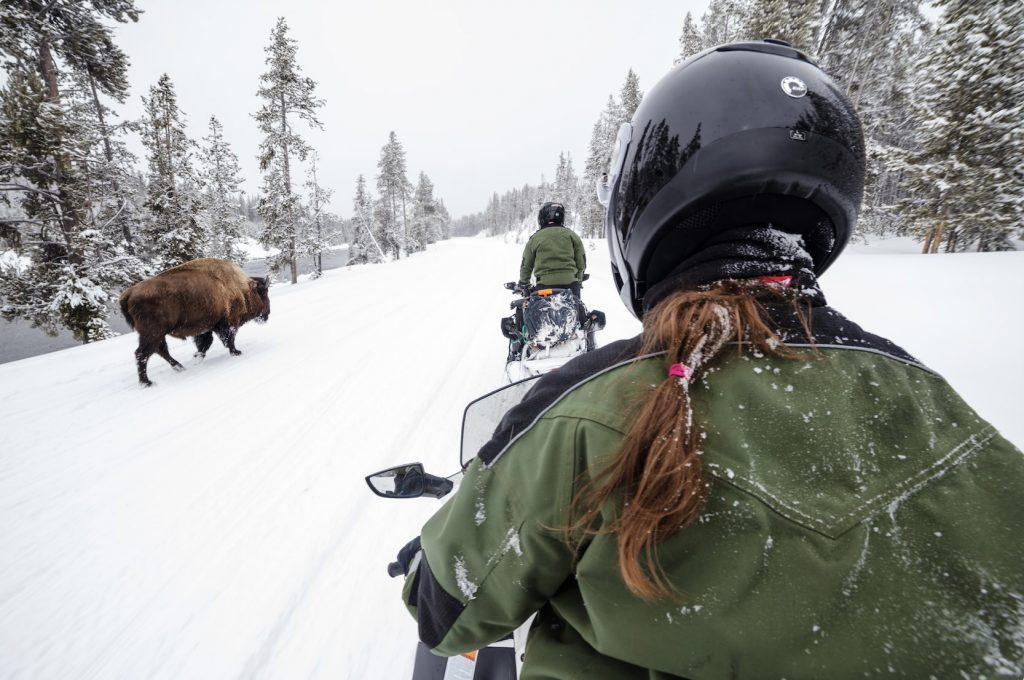
CODY, Wyoming – It’s no secret that Yellowstone National Park can be jampacked in the summer, when up to one million people jockey for space each July. But February typically draws fewer than 50,000 visitors. That makes winter the best time to beat the crowds, as well as to experience a captivating and seldom-seen world revealed only when the park is covered in snow.
In winter, wildlife shows up in stark relief against an undulating sea of white. The roar of bus engines and clatter of motorcycles are replaced by the hiss and gurgle of flaring fumaroles and bubbling mud pots, and the quiet crunch of snow underfoot.
Winter weather varies from blue-sky days in the 30s to whiteout blizzards at 20 below zero, with conditions that are often comparable to those at any Rocky Mountain ski hill. Traveling with a group is important for safety, along with dressing warmly in layers and wearing insulated, waterproof boots and gloves.
Yellowstone’s winter season runs from mid-December to early March, with activities — which are all about the snow — ranging from mild to wild. Bring a separate camera with a telephoto lens, and always give animals plenty of space. Then brag to everyone about why your winter adventure was so much better than their summer visit to the world’s first national park.
Take a Weird Walk Through Meow Wolf’s Expanding Universe

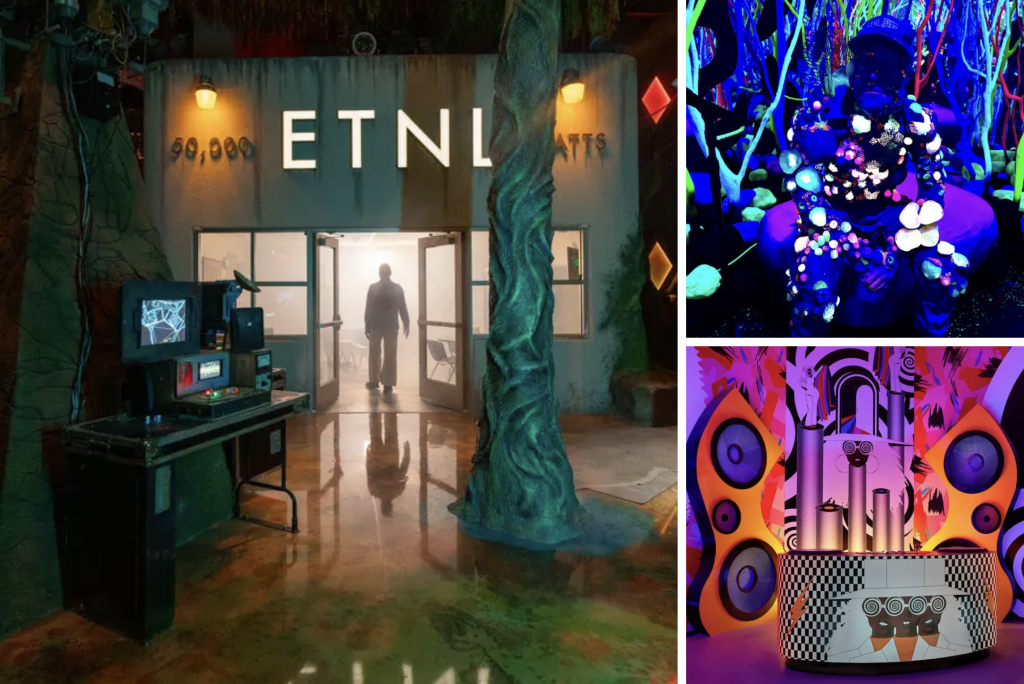
It was gray and drizzly in Houston — a perfect day to be sucked into an alternate universe.
A mysterious statue of a bearded man encrusted head to toe in pastel shells, barnacles and other sea life caught the attention of two visitors. One of them, a young boy, uttered a few words into a microphone, and suddenly the creatures began to pulse and glow. A symphony of chirps, squawks and sounds reminiscent of whale songs and pipe organs resonated through a forest of neon-colored coral.
Lisa Hlavacek, 35, and her 3-year-old son, Arthur, were visiting Radio Tave, the latest immersive art exhibition by the group Meow Wolf. It was Ms. Hlavacek’s sixth visit since it opened last October.
These national park trails were created by America’s first Black soldiers

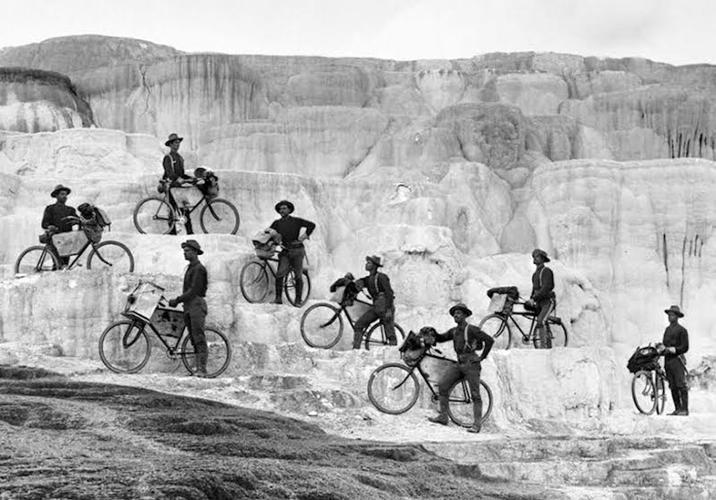
You may not have heard about the Buffalo Soldiers, but they were professional Black enlistees serving in the first segregated regiments of the regular peacetime U.S. Army formed after the Civil War. But you have no doubt benefited from the legacy they left in America’s national parks and you may have even traversed the roads and trails they built.
According to lore, these men were nicknamed Buffalo Soldiers by the Plains Indians who fought against them (in the late 19th century) because their dark, curly hair resembled buffalo fur, and out of respect for their fierce and stalwart actions in battle.
Thousands work behind the scenes to keep Yellowstone running

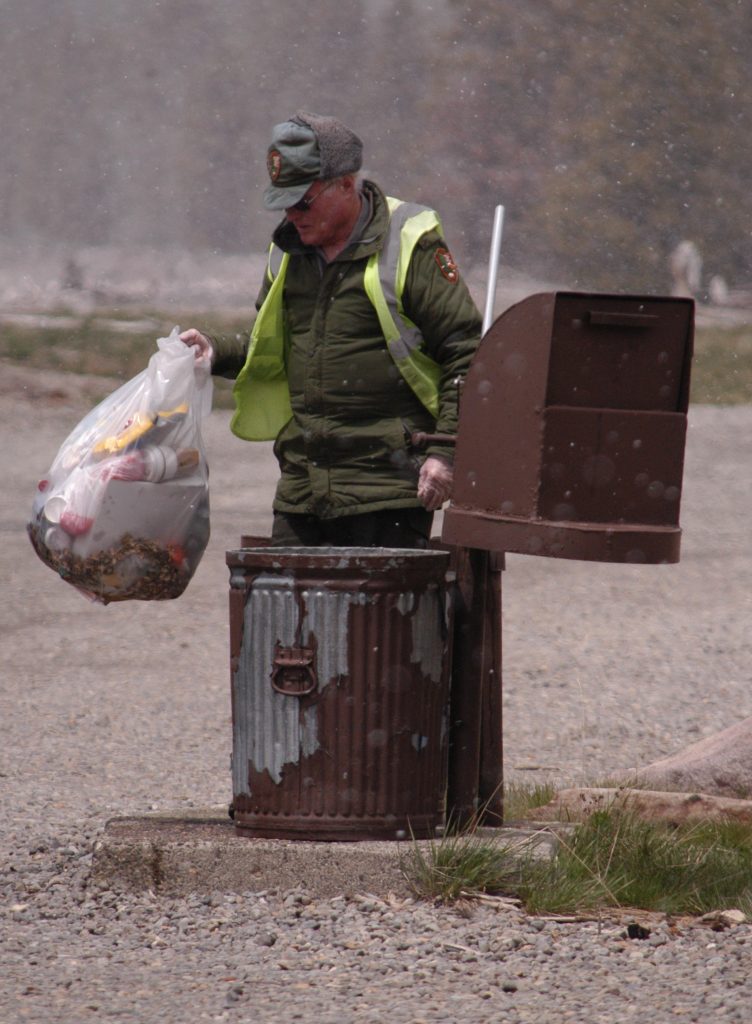
CODY, Wyoming (Reuters) – For more than a decade, Richard Ranc has worked a summer job emptying trash cans, cleaning restrooms and performing minor repairs. The work comes with some of the most spectacular views in America, but there’s always the risk of a bear attack.
“I go from contrasting mountain forests to mud volcanoes to lakeside shorelines,” said Ranc, a seasonal maintenance worker whose daily truck route takes him on a 110-mile (180-km) round-trip journey through the scenic splendor of Yellowstone National Park.
>>>READ MORE
Firings Squeeze National Parks: ‘You Won’t Have the Full Experience’

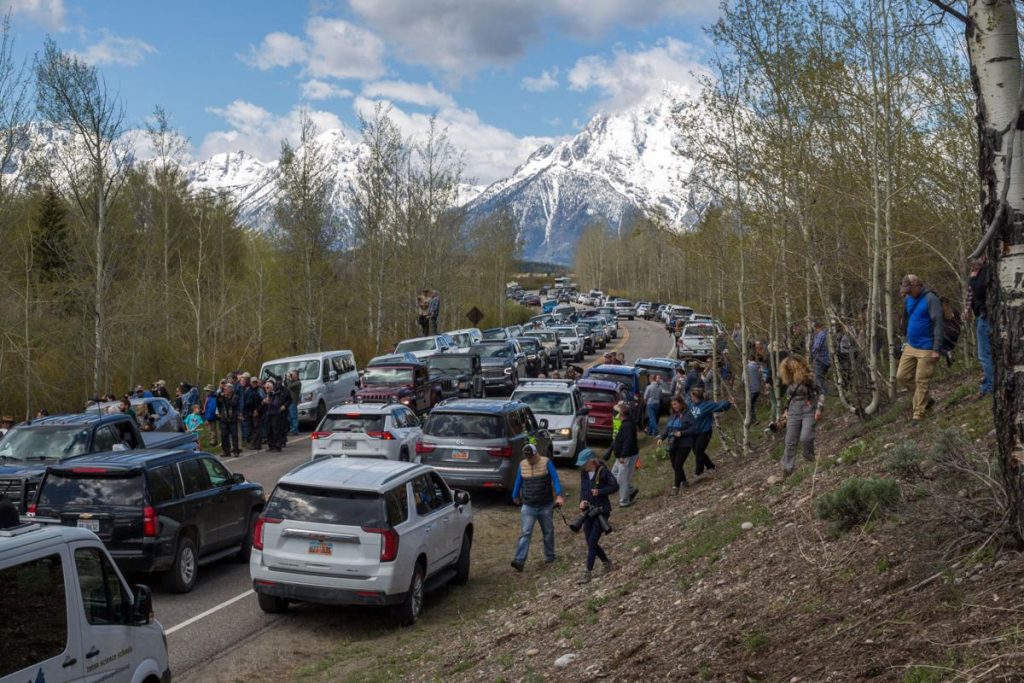
The abrupt dismissal of at least 1,000 permanent National Park Service employees on Feb. 14 has brought a torrent of “I was fired from the N.P.S.” posts cascading down social media feeds like the luminous Yosemite firefall.
At least 3,000 additional people were fired from the U.S. Forest Service, which often works in concert with the parks. And thousands more seasonal workers were questioning if they would have jobs, despite a memo from the U.S. Department of the Interior, which oversees national parks, approving 7,700 temporary positions, slightly more than usual. The park service usually operates with about 20,000 total employees, including approximately 7,000 seasonal workers.
Moving Heavy Metal at High Altitude in Yellowstone
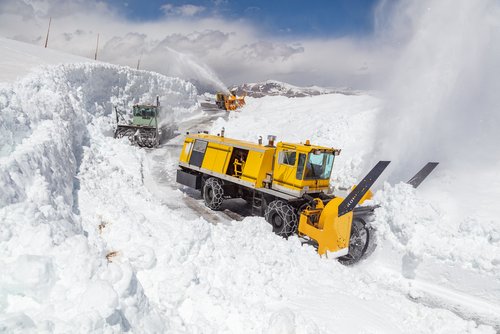
CODY, Wyo. — For several days this spring — after Yellowstone National Park had closed to snowmobiles and snow coaches, but before it had opened to automobile traffic — road maintenance crews there were burning through 1,500 gallons of diesel fuel per day. But they were hauling nothing and not building anything. In fact, they were making no permanent changes to any roads.
They were plowing snow.
In a majorly mechanized and carefully choreographed rite of spring that rivals any annual display made by flora or fauna, dozens of skilled workers operating a vast assemblage of heavy metal spend weeks each April and May breaking up ice and plowing snow in a race to open vast stretches of Wyoming’s most scenic byways in time for Memorial Day weekend.
>>> READ MORE
Travel & Tourism • Investigative • Features & Assignments • Profiles
Investigative Reporting
Oversight and investigative reporting are time-consuming and costly endeavors that are vital to healthy communities and well-functioning democracies. I am grateful for the opportunities I’ve had to do in-depth reporting on complex topics, and I hope to continue my award-winning investigative work for many years to come.
Bureaucracy clouded details of man’s fatal grizzly mauling
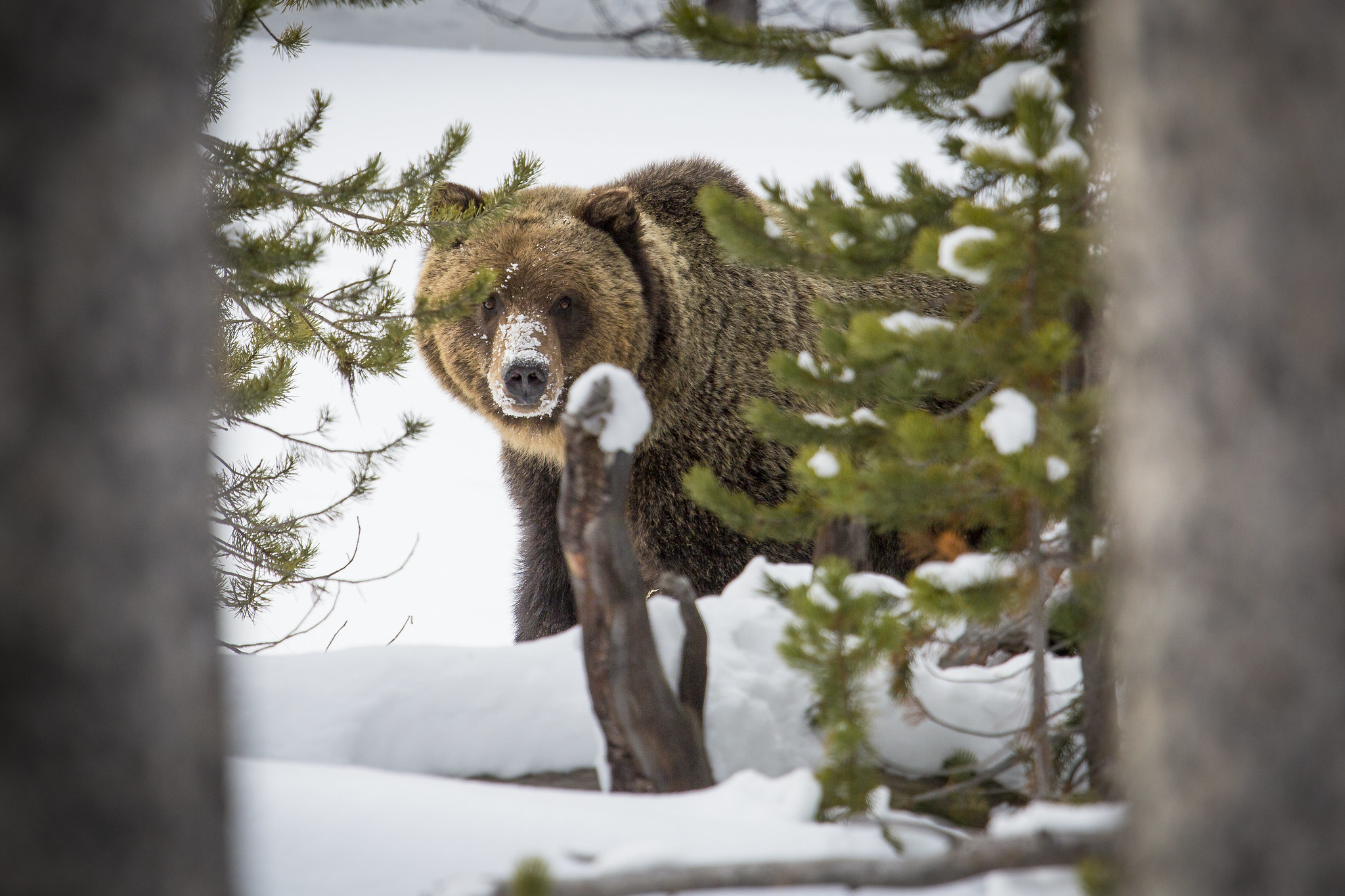
CODY — Fatal bear attacks are rare, and the deadly mauling in June of a botanist by a grizzly bear that researchers had trapped and released just hours earlier is thought to be the first and only such incident in the United States.
Any attack on a human by a predator draws intense scrutiny from the news media and the public. But bear attacks around Yellowstone National Park happen in a politically charged climate where every rumor, fact and utterance can become fodder for a wider debate on wildlife management.
So it is hardly a surprise that in the two days following the death of Erwin Frank Evert, 70, of Park Ridge, Ill., various officials responding to the incident knew many of the same important details, but had different opinions about how, whether and when to share that information.
Internal communications and other documents from federal, state and local agencies gathered using public records laws show that wildlife officials closely monitored media coverage of Evert’s death. But there was no single authority that represented a unified voice for a diverse group of individuals and agencies involved in grizzly bear management.
Factory plans appear based on little more than fantasies
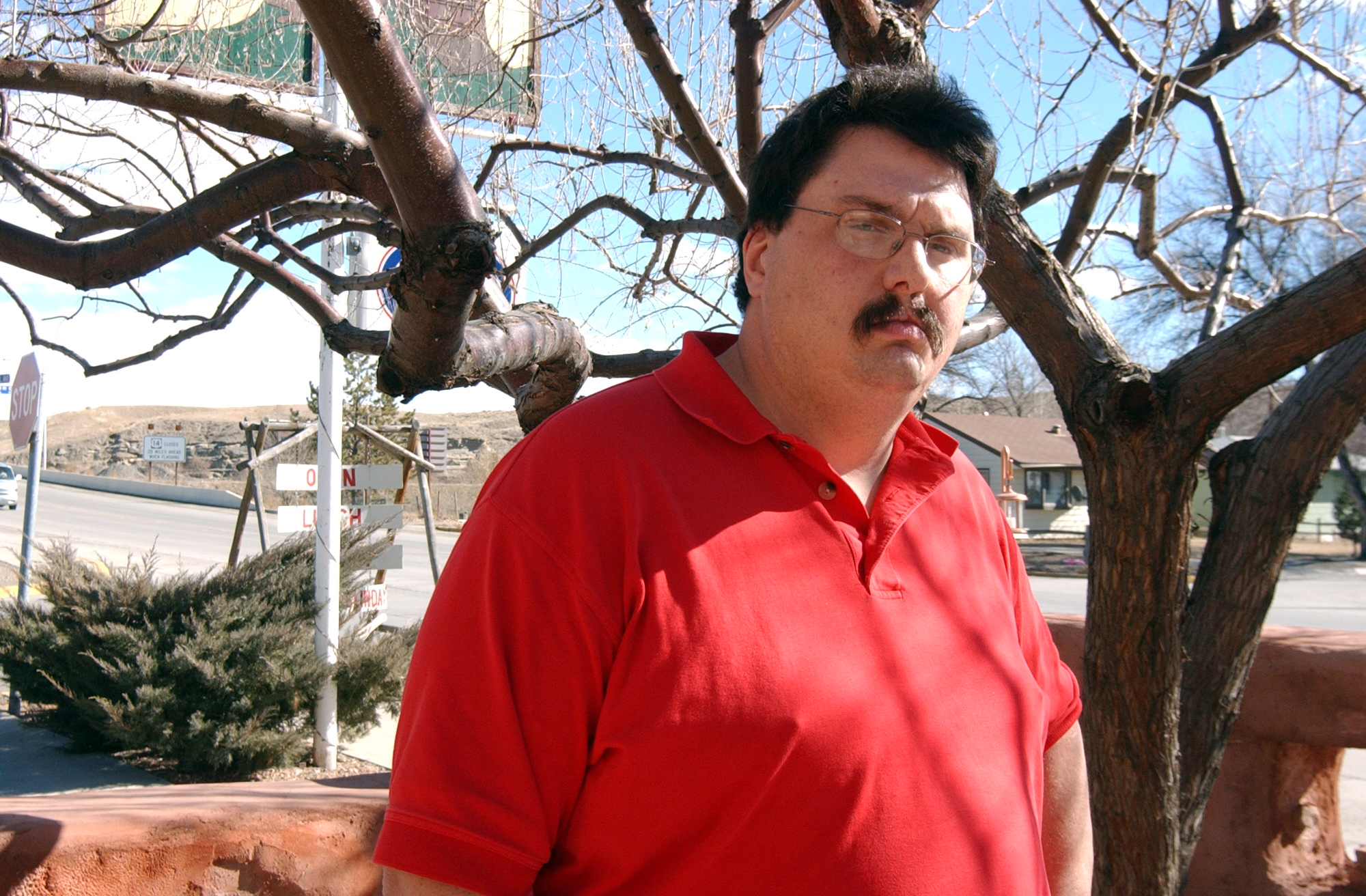
GREYBULL, Wyo. — The vision Dan Madson pitched to the people of Greybull seemed like an answer to their prayers.
He proposed building a steel processing plant, Kardan Steel, that would employ 250 people in high-paying positions with good benefits. It seemed like a perfect fit for an area sorely lacking such jobs.
The whole idea sounded almost too good to be true.
Turns out it was.
After seven months of touting his plan to privately finance and build a multimillion-dollar facility on the site of a former oil refinery, Madson has produced nothing.
Safety record in question at Mount Carmel Youth Ranch
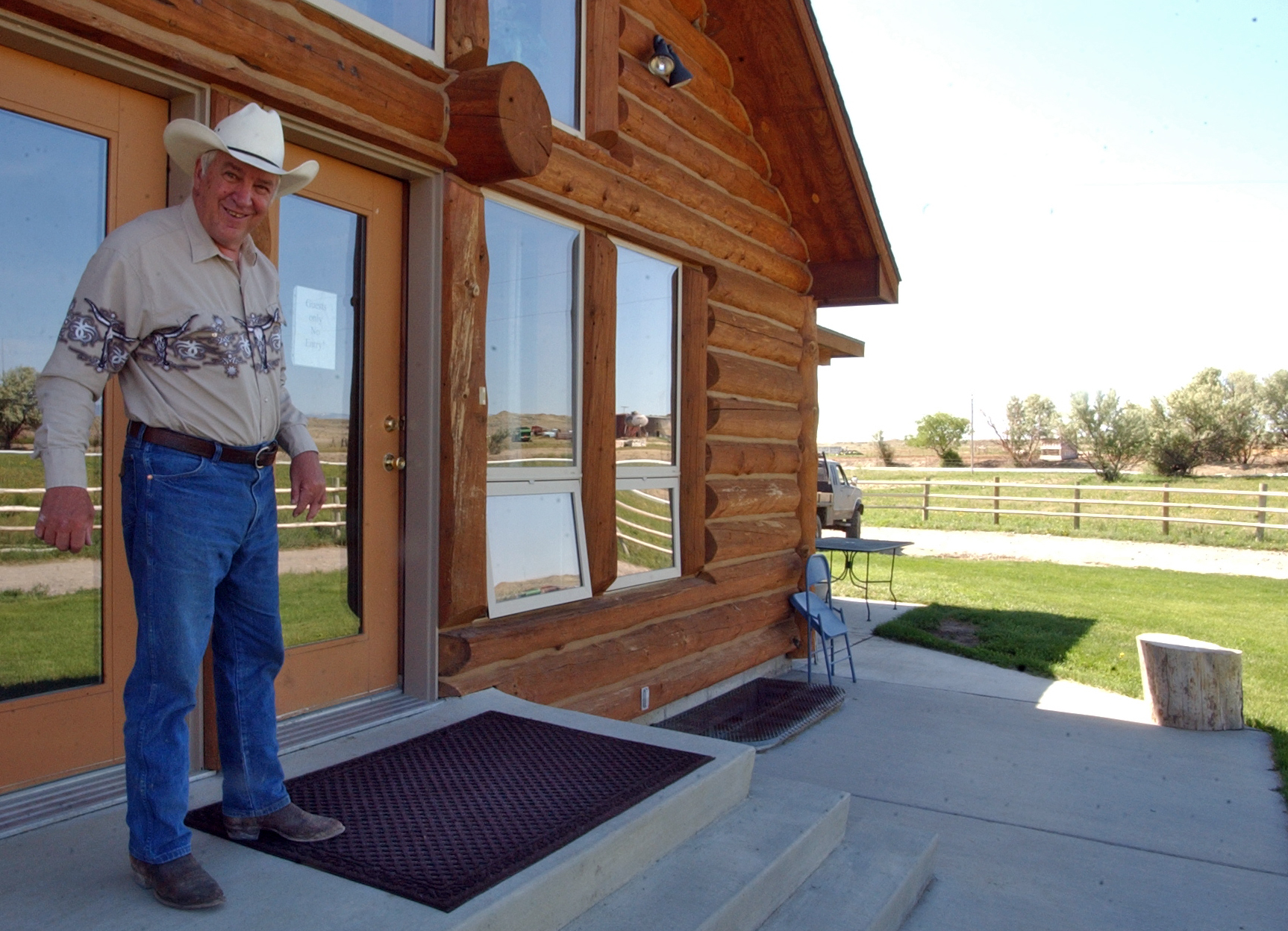
CLARK, Wyo. – Along the well-traveled highway between Cody and Billings, a wooden sign at a gravel turnoff pointing east into starkly beautiful high desert says “Mount Carmel Youth Ranch 3 miles.”
Few take the turnoff, and indeed few people know much about the youth ranch and what it does.
What most people may know about Mount Carmel Youth Ranch comes from news stories about an assault in September 2005 in which three boys used shovels to brutally beat a sleeping counselor.
That incident – in which John O’Brien, just nine days on the job, suffered severe, permanent head injuries – was neither the first nor the last serious occurrence at the ranch.
A review of dozens of public documents shows a history of problems over the past several years, including multiple failures to report some incidents to the state Department of Family Services, as required by agency rules.
Workers question double standard in unemployment benefits vote

CODY, Wyo. — Before Wyoming felt the cumulative effects of the 2007 credit crunch, the 2008 real estate collapse and a punishing national recession, homebuilder Nick Randol had 15 people working for his construction company. Today, he employs four.
“A two-year drought of work hasn’t been real prosperous, or even profitable,” said Randol, a general contractor in Cody who has seen some of his former employees file for unemployment, while others found work in the agricultural sector.
>>> READ MORE
APF head Hilton has history of legal trouble, served time in prison for theft

Michael Hilton of American Police Force arrived in Hardin with promises of Mercedes police cars and expertise in operating prisons. He delivered the cars last week, but may have learned about prisons following a 1993 conviction for grand theft.
Public records from police and state and federal courts in California show that Michael Anthony Hilton, using that name and more than a dozen aliases over several years, is cited in multiple criminal, civil and bankruptcy cases, and was sentenced in 1993 to two years in state prison in California.
Hilton pleaded guilty in March 1993 to 14 felonies, including 10 counts of grand theft, one count of attempted grand theft and three counts of diversion of construction funds, according to Orange County court records. He was sentenced to two years in prison, but it is unclear how much time he served.
Court records in that case list his real name as Michael Hilton, but they also include the aliases Midrag Ilia Dokovitch, Midrag Ilia Dokovich and Michael Miodrag.
Kangarloo ‘s businesses see ups, downs after flight from Iran

In his hometown of Mashad, Iran, real estate developer Hassan Kangarloo grew up in a family he describes as “very wealthy and famous,” thanks to his late father’s success in business and politics.
But the Iranian Revolution of 1979 toppled Mohammad Reza Pahlavi, Iran’s shah, or monarch. Fearing retribution for their ties to the shah, Kangarloo and his family fled the country, leaving behind what he said was a fortune in assets, including commercial aircraft and real estate.
Since moving to the United States around 1980 while in his early 20s, Kangarloo, now 49, has worked to restore the family fortune, meeting with mixed success along the way.
Much of his story – including his financial troubles and a criminal conviction in 1986 for selling restricted military parts to Iran’s government under Ayatollah Ruhollah Khomeini – is detailed by Kangarloo in his own words in court documents.
Travel & Tourism • Investigative • Features & Assignments • Profiles
Features & Assignments
Working for several years as the Wyoming bureau chief for the Billings Gazette, Montana’s largest daily newspaper, I had the good fortune to receive assignments and generate my own leads for coverage of the Bighorn Basin. This vast area of northwestern Wyoming, larger than New Jersey and Connecticut combined, was one of the last places settled by white European-Americans. Its lingering wild and wooly character makes for endless stories about the land, work and folk along one of America’s last frontiers.
Plague vaccine may help ferrets bounce back from brink
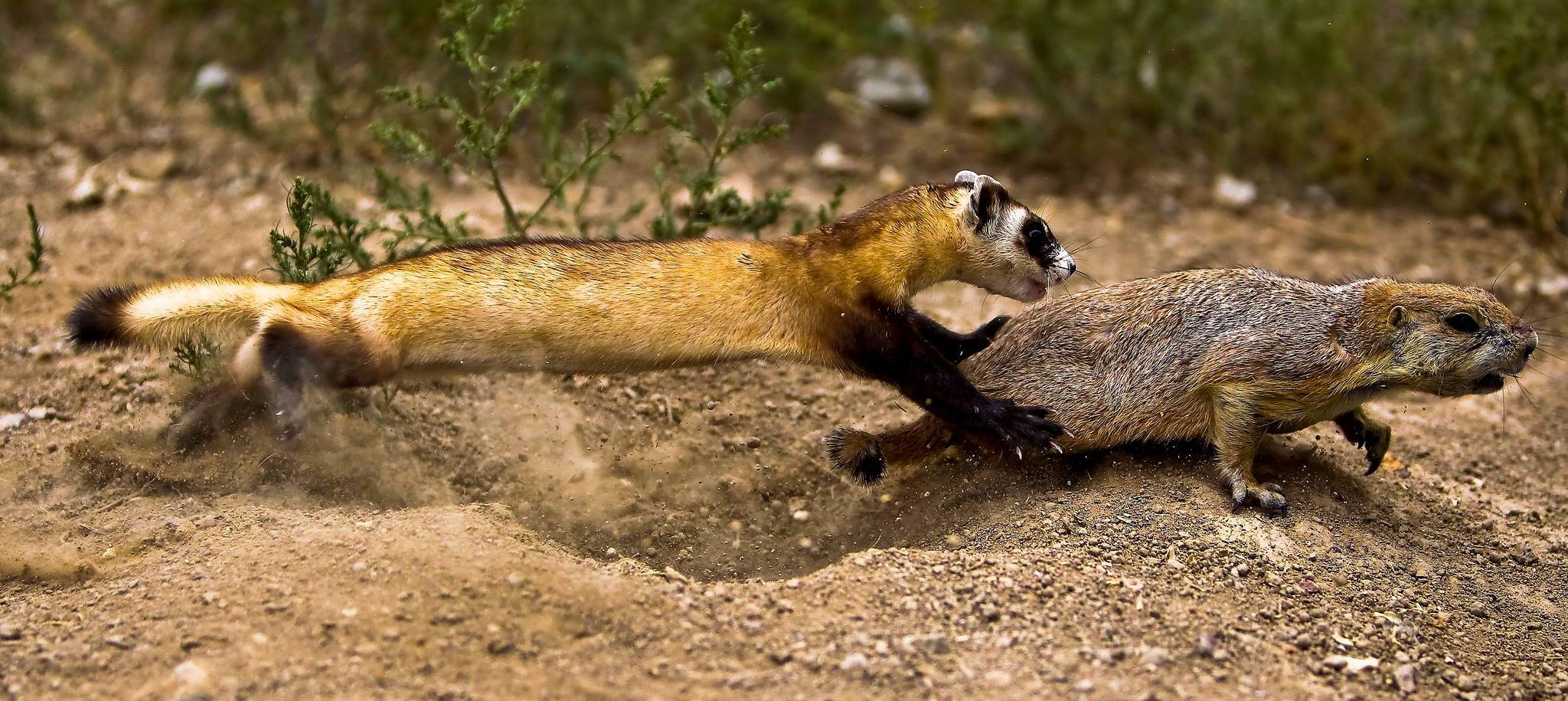
For a couple hours last week, about three dozen people stood under ominous storm clouds, wandering across a windswept meadow near Meeteetse, Wyo., hoping to catch a glimpse of prairie dogs eating peanut butter.
It wasn’t just peanut butter the wild rodents were ingesting. In fact, the tasty treat was merely the irresistible flavor used in a bait laced with an oral vaccine being tested as a way to control plague among limited populations of wild animals.
And since the gathering of reporters, wildlife officials and researchers was at the Pitchfork Ranch, there was also plenty of discussion about the endangered black-footed ferret.
It was at the Pitchfork that a colony of about 120 black-footed ferrets — the last in the world — was discovered in 1981, long after the animal was thought extinct.
Unconventional subdivision proposal draws skepticism in small ranching community
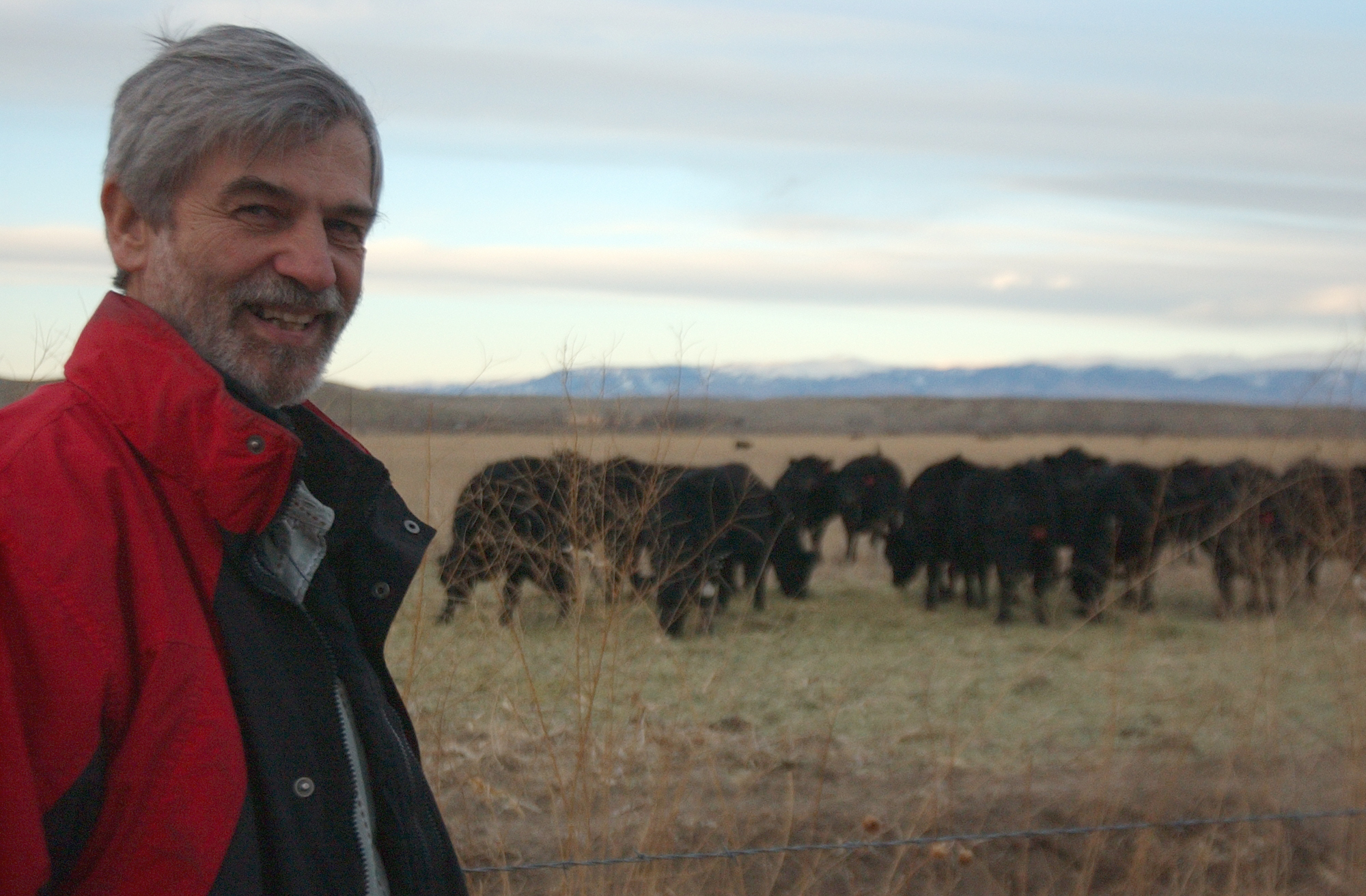
BASIN, Wyo. — The scene has played out many times before across the West—a real estate developer facing pointed questions about plans for a housing development that would encroach on rural farmland.
But this time, the proposed 137 tightly clustered homes weren’t part of suburban sprawl near Denver or Salt Lake City. These were planned for the wide-open spaces of Big Horn County, which has a population density of four people per square mile.
“This is driven by the concept that you can preserve farmland while creating
housing, instead of just taking the land and chopping it up,” said Bob Elliott, who is proposing the development. He is an organic cattle rancher seeking to subdivide his Dorsey Creek Ranch.
Elliott’s 750-acre property is situated along the banks of the Greybull River, six miles west of Basin on a mostly flat expanse of wind-swept valley in the shadow of northwest Wyoming’s Bighorn Mountains. Home to about 1,300 people, Basin is an agricultural community and the county seat for Big Horn County.
More than 30 people crowded into a cramped courthouse basement meeting room in mid-February for a tense and emotional public hearing on Elliott’s proposal.
Police seize ‘good boy’ parakeet in front of frightened kids
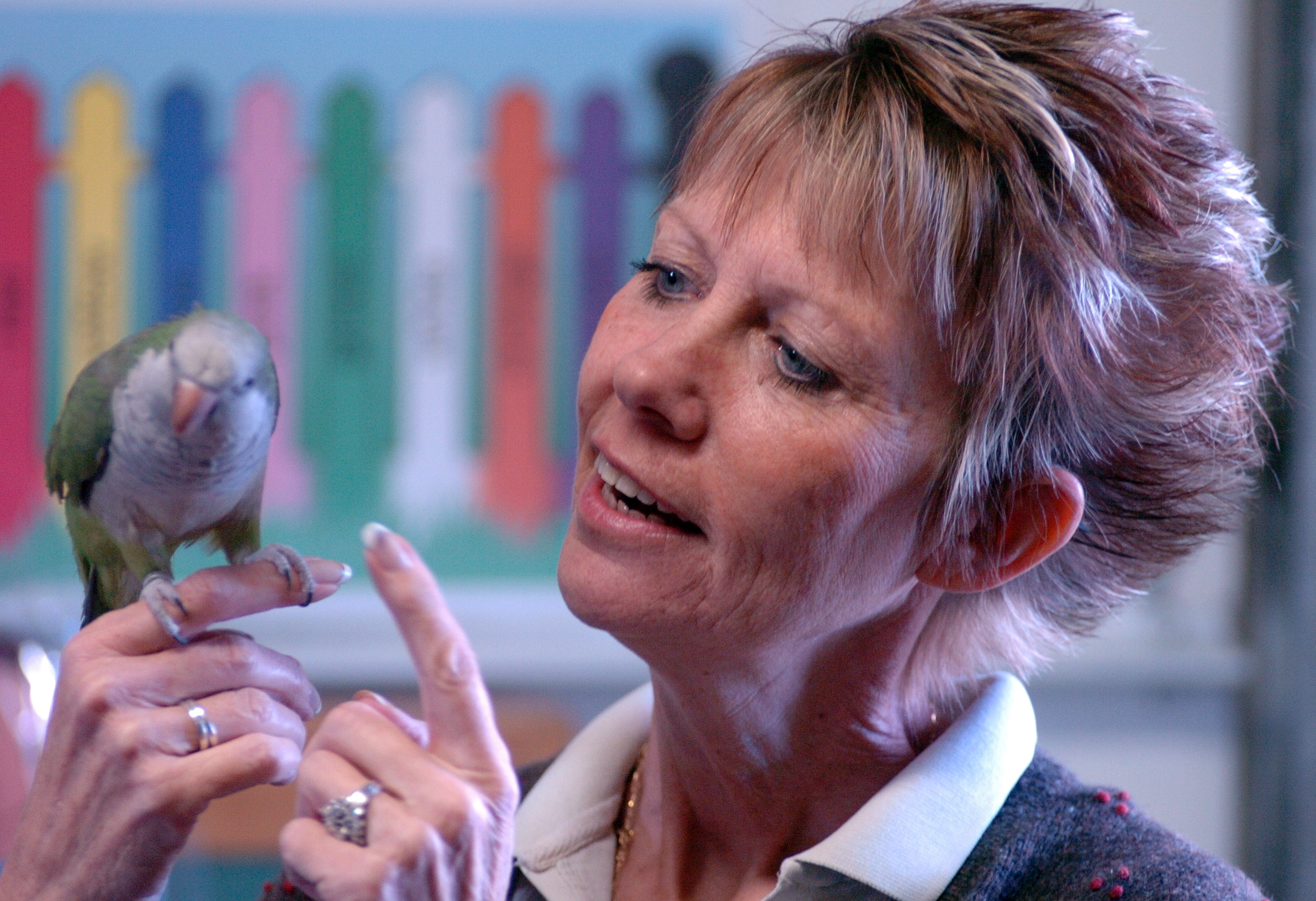
CODY – Pete is a good boy, and he is usually the first to tell anyone that.
In fact, he was loudly proclaiming his goodness when the authorities carted him off to face an uncertain future, possibly even an untimely death at the hands of the law.
“The whole time they were confiscating him, he was saying, ‘I’m a good boy. I’m a good boy,’ ” said Debbie Dawe, owner of Sweet Pete, a Quaker parakeet she has had since June.
Also called Monk parakeets, Myiopsitta monachus are considered an invasive species and a potential agricultural pest in Wyoming, where they are banned under state Game and Fish Commission regulations.
So when Dawe placed an ad in the newspaper to sell the bird, she got a call from the Game and Fish Department that led to its seizure. The experience left her mad as a wet hen, but it looks like things will end in a pardon for Pete.
Yellowstone Quarterly: Cougar Project uses cutting-edge tech to follow elusive predator
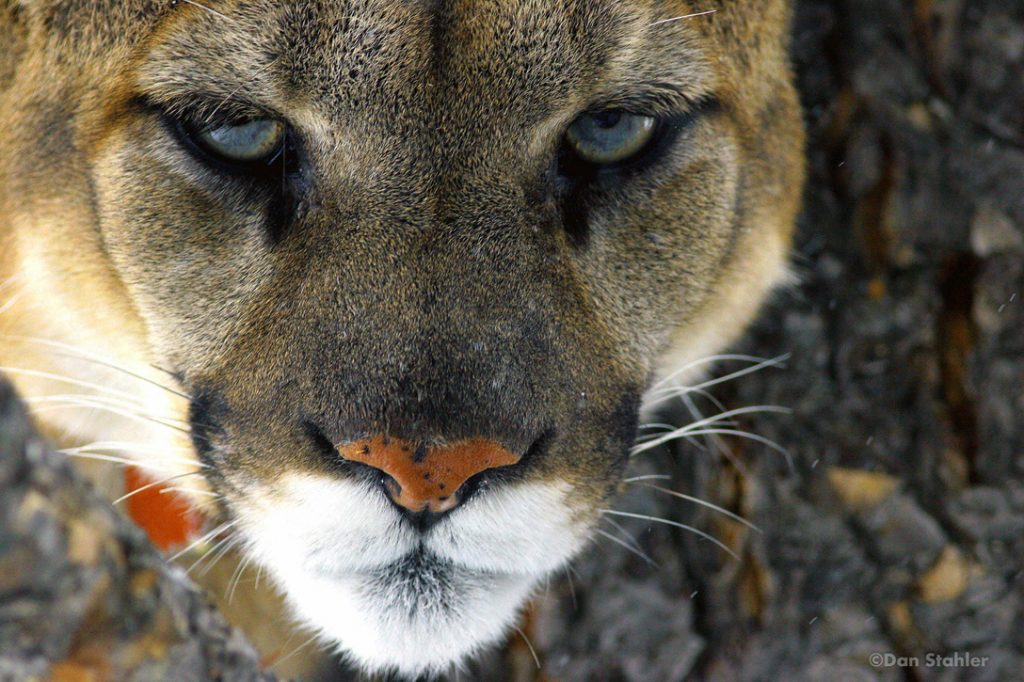
The young male wasn’t an Olympic athlete in training, but his daily movements were tracked and recorded with amazing precision. He wasn’t on a crash diet, but what he ate was well-known, along with where and when he ate it. He wasn’t a patient with a rare or fatal disease, but his entire genome was sequenced. And he wasn’t a crime victim, although his violent death at a young age was determined by lab work and an arduous field investigation.
The young male was M198, one of the first cougars fitted with a special tracking collar that is a cornerstone of the Yellowstone Cougar Project. Begun in 2014, the planned five-year study is using a range of high-tech, non-invasive methods to better understand how many cougars live in the park—particularly in the northern range. The project also studies how the big cats fit into the larger ecosystem of major predators in Yellowstone National Park that includes grizzly bears and gray wolves.
Yellowstone wildlife biologist Dan Stahler leads the Cougar Project, which uses a combination of tracking collars, genetic analysis, camera traps and field work to “reveal the fascinating ecology of how cougars are connected to this wild landscape.”
Central Asian throat singers bring their ancient art to region
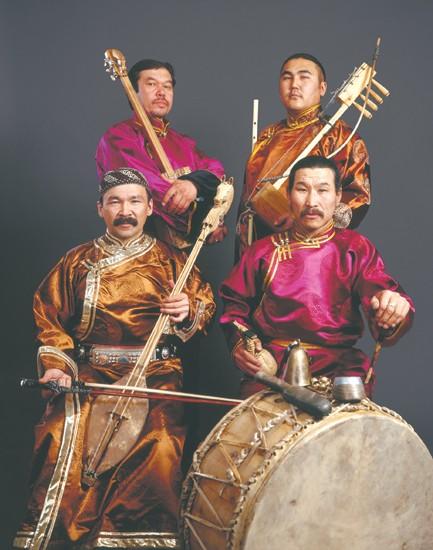
MEETEETSE, Wyo. – A quartet of singing horsemen might seem like a predictable band to perform in a town that has seen more than a century of ranching, riding and roping.
But no one could have predicted the huge crowd Tuesday night in the school gymnasium, or the rousing standing ovation for four men who played traditional central-Asian songs dating to 13th-century warlord Genghis Khan.
Performing in period formal wear on traditional instruments, Huun-Huur-Tu have played more than 1,000 shows in Europe and America, said Vladimir Oboronko, the group’s manager.
But their trip to Meeteetse this week was like a homecoming of sorts, said Sayan Bapa, a co-founder of the band who plays the doshpuluur, a guitarlike instrument covered in snakeskin.
Airmen practice evasion, escape in Wyoming
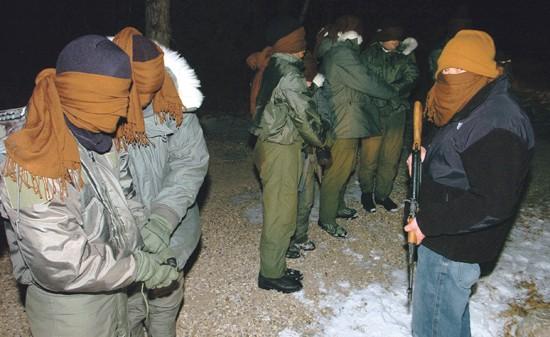
CODY – For five days earlier this month, eight active-duty U.S. Air Force personnel made their way across hostile territory, working with friendly locals to avoid capture by enemy forces and reach the safety of a foreign border 500 miles away.
The enemy country was the fictional “Republic of Wyoming,” with the free state of Colorado the closest haven. And if you had no idea that the airmen and dozens of local partisans were operating across the Cowboy State, then they accomplished their goal.
The wide-ranging training exercise offered a little bit of everything that a downed air crew might encounter in a place like Afghanistan, including tense encounters with unpredictable guerrilla forces, in this case played by local residents.
As they made their way across the state, the six men and two women of varying ranks and specialties faced bitter cold, hid in tight crawl spaces, rode in horse trailers and were even challenged to make a meal of rabbits and chickens after days of little food or sleep.
Travel & Tourism • Investigative • Features & Assignments • Profiles
Profiles & Wyoming Life
Wyoming is America’s least populous state, and has the fewest residents per square mile after Alaska. So it’s no wonder the people that choose to live here are a breed apart from most folks you might encounter in the increasingly homogenous sprawl that makes up much of the United States. Sharing the stories of those who are carving a life out of some of the country’s most challenging terrain is a privilege I will never take for granted.
‘Rain Man’ inspiration works to promote understanding
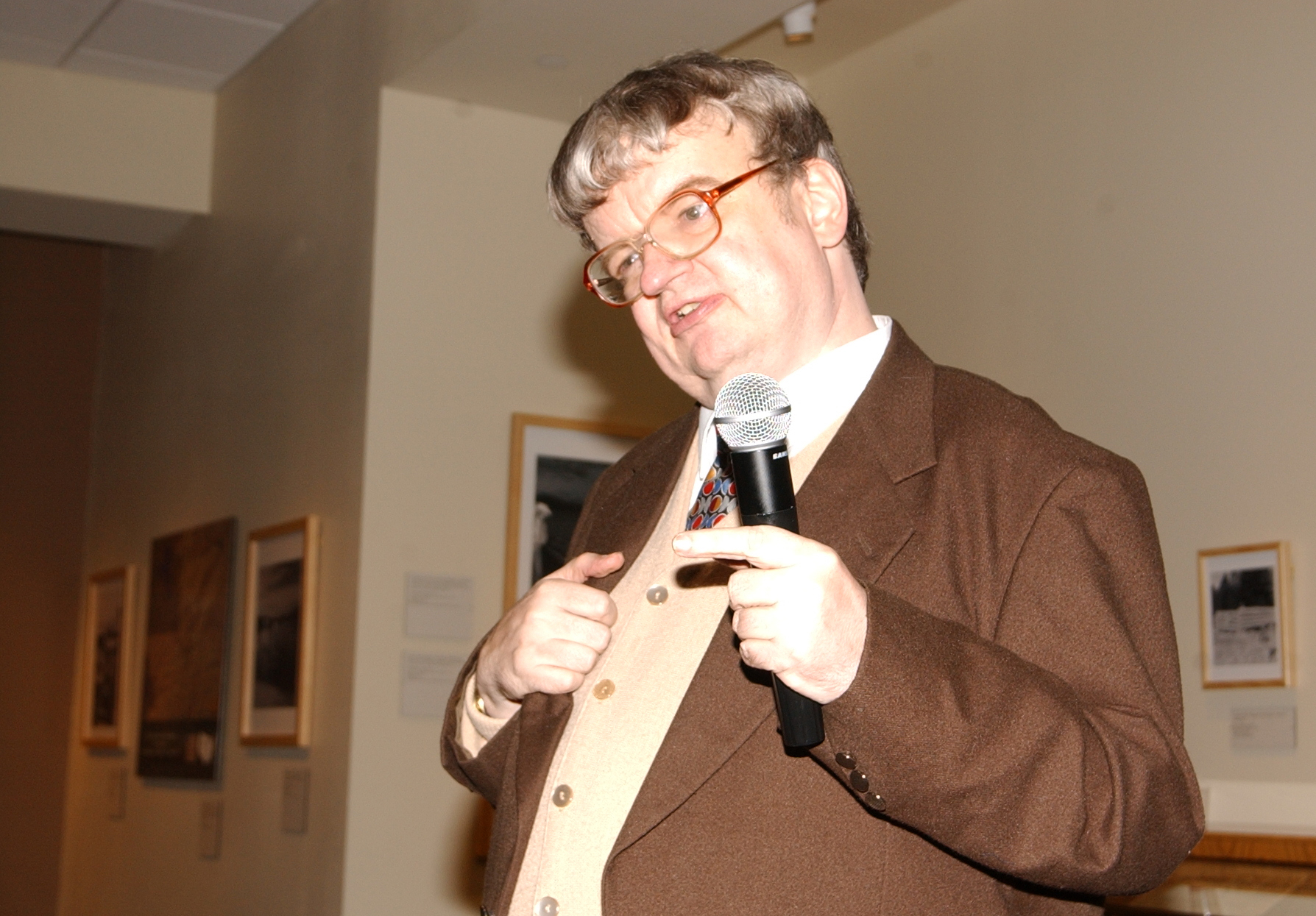
CODY – Kim Peek can tell you when you’ll retire, but he’s not an investment advisor. He can tell you the names of every pitcher in the 1959 World Series, but he’s not a sportscaster. He can tell you the ZIP code of any town in America, but he’s not a postmaster.
Peek is just amazingly different from anyone you’ll ever meet.
“You don’t have to be handicapped to be different,” Peek said Wednesday at the Buffalo Bill Historical Center in Cody. “Everybody’s different.”
Along with his father, Fran Peek, Kim spoke as part of a program sponsored by NOWCAP Services, a Wyoming nonprofit organization that provides services to people with developmental disabilities and acquired brain injuries.
The world’s most famous autistic savant, Kim Peek was the inspiration for the film “Rain Man,” and his incredible mental abilities far surpass those of the Raymond Babbitt character in the movie.
Tough as nails, but gentle as a lamb
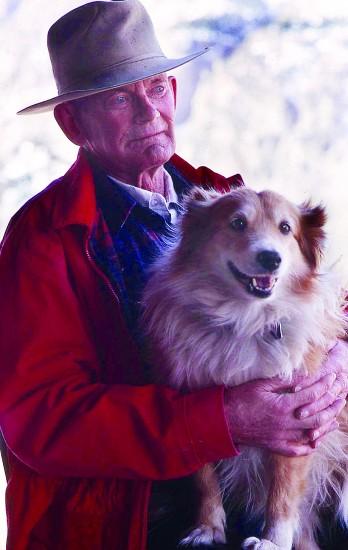
CODY – In Wyoming, there are a few occupations in the great outdoors – rancher, oil field worker, backcountry ranger – that seem to define what life in the Cowboy State is all about. Burns Biggs has done them all.
Biggs also spent several years in the U.S. Army, fighting in World War II and the Korean War.
And though he retired in 1996 from the U.S. Forest Service, Biggs, 87, still gets calls from hikers, outfitters and hunters looking to tap his encyclopedic knowledge of Park County’s wilderness.
Bataan Death March survivor finds mercy
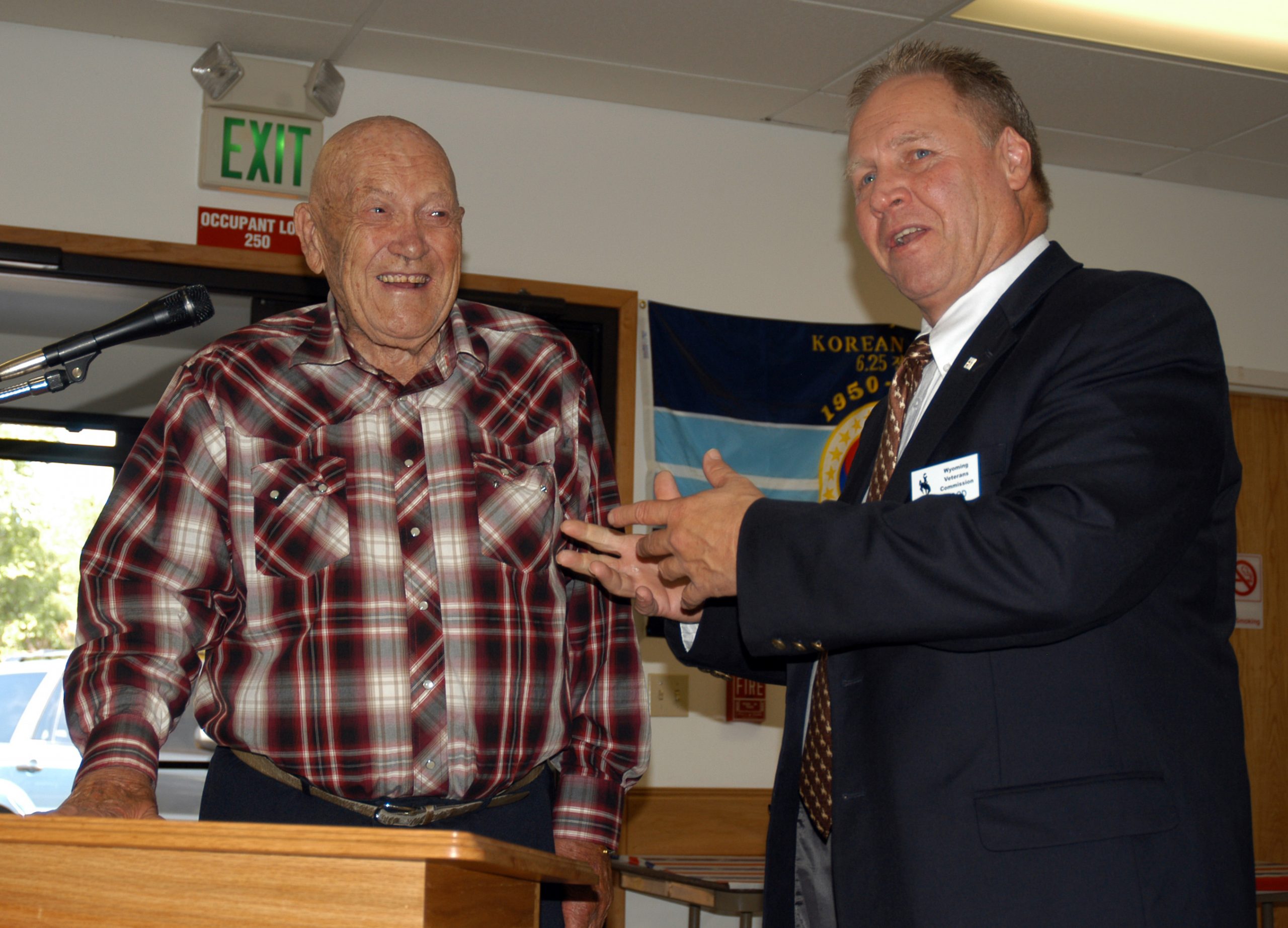
CODY – Just before the Japanese began bombing Clark Field in the Philippines, shortly after the attack on Pearl Harbor, Leonard Robinson and two of his friends were off getting lunch for the others in his platoon.
Robinson got separated and missed his ride back, but the truck carrying his friends was struck by two bombs, and both men were killed.
“I figured that, by the grace of God, there’s usually a survivor to everything, and I will be that survivor,” Robinson said Friday.
What Robinson didn’t know then was that he would live through one of the most brutal experiences of any prisoner of World War II, surviving the infamous Bataan Death March and more than three years of forced labor under inhuman conditions.
Flitner family sees value in ranching as way of life
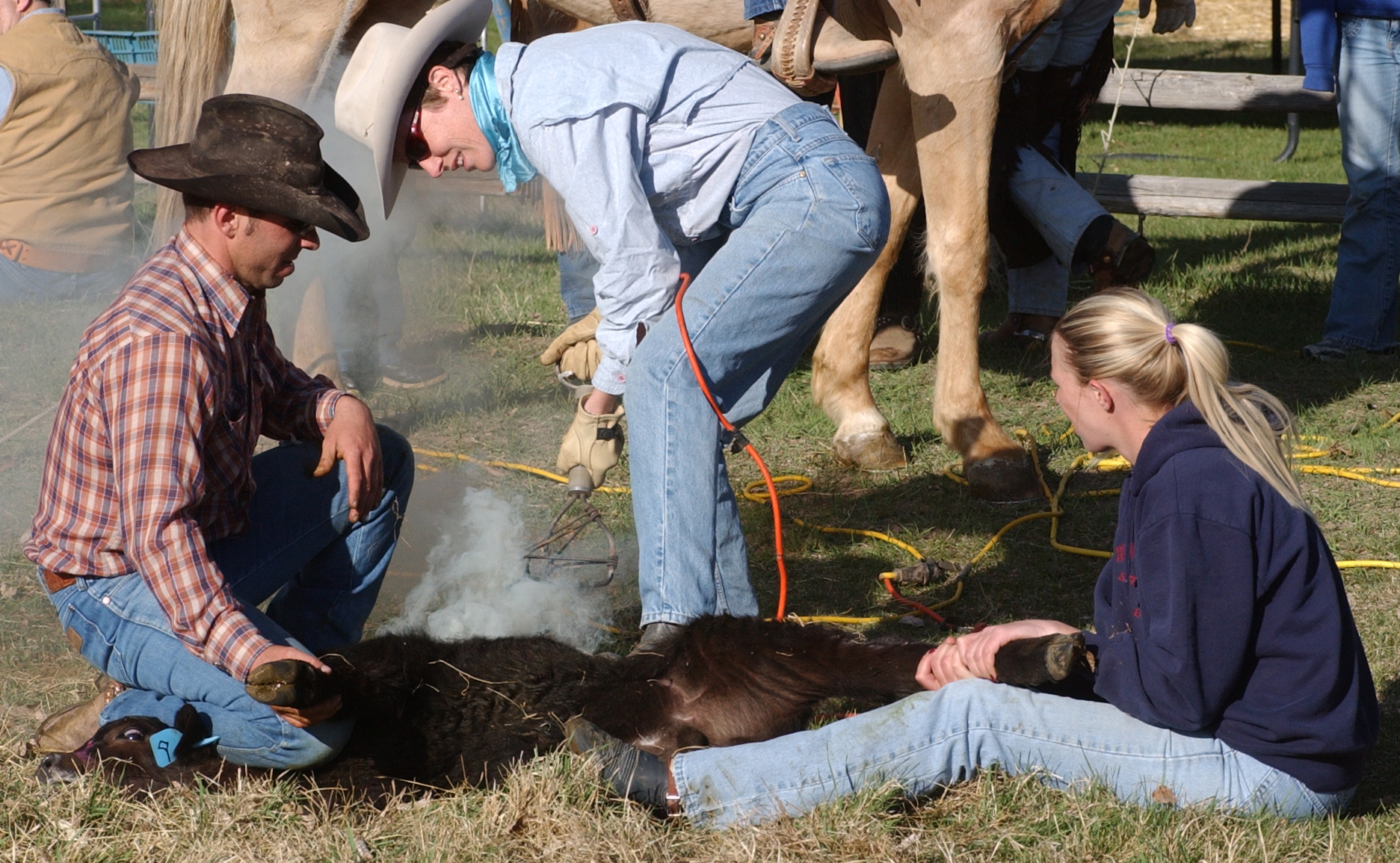
SHELL, Wyo. — When Arthur Flitner came to Wyoming, he bought 160 acres in the Shell Valley for $30 an acre, and 160 head of cattle for $24 each. He began operating the Diamond Tail Ranch in 1906.
His grandson, Stan Flitner, figures the economics of ranching haven’t changed much in 100 years, at least by one benchmark.
“That’s still about what an acre of land is worth for ranching — around the same as what you’d pay for a cow,” said Flitner.
But plenty else has changed, with the ranching business seeing cycles of boom and bust, and four new generations of Flitners working the land.
In a modern culture that both idealizes and ignores the struggles of the family rancher, the Flitners continue to do what they’ve done for the past century — plan for the worst, hope for the best, and work as hard as they can to leave something worthwhile for the next generation.
Event draws gunslingers from all over
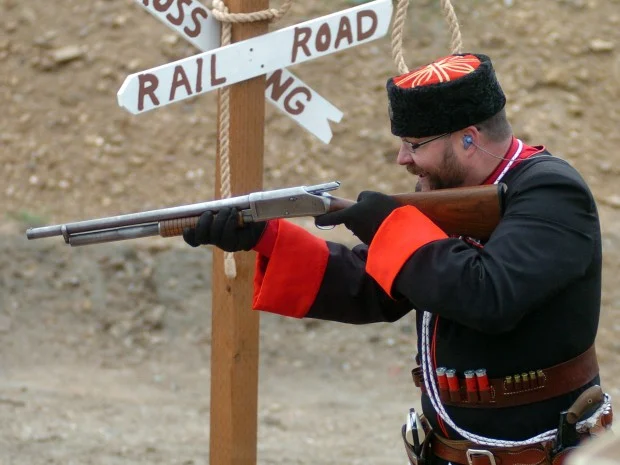
CODY — It was a cold and dreary morning Friday when Belle Drewry started shooting at the train, but her two revolvers slung hot lead. By the time she had emptied them, along with her rifle and a shotgun, Drewry had taken out more than two dozen cowboys in less than a minute.
Luckily for Drewry, whose real name is Kari Hardy, the train was imaginary and the cowboy targets were steel silhouettes.
The “train robbery” was one of 10 scenarios set up for participants in Cody’s Wild West Shootout, an event that combines shooting, history and role playing in a highly social activity enjoyed by thousands of competitors around the world.
“It’s just a gas,” said Hardy, who works for a Cheyenne restaurant equipment firm. “The people you get to meet are great, and they come from all over.”
Hardy and more than 85 others, including shooters from New Zealand and Canada, are competing this weekend in the Wyoming Cowboy Action Shooting championship match. Participants must wear period costumes reflecting Old West styles from 1860 to 1899, and must use guns from the same era.